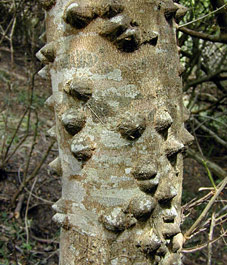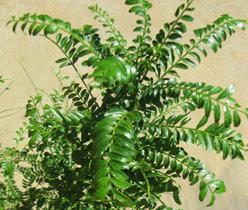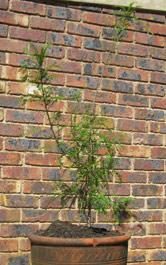Zanthoxylum capense
Zanthoxylum capense (Thunb.) Harv.
Family: Rutaceae
Common names: small knobwood (Eng.); kleinperdepram (Afr.); umlungumabele (isiXhosa); umnungamabele (isiZulu); monokwane (Sotho); khunugumorupa (Tsonga)
SA Tree No: 253
Introduction
A large number of Zanthoxylum species have been studied and most of them contain biologically active benzophenanthridine alkaloids. Of particular significance is sanguinarine and related alkaloids. Sanguinarine has anti-plaque and anti-inflammatory activity and is commercially used in toothpastes and oral rinses. It binds selectively to the dental plaque and almost completely inhibits bacterial growth, even at low concentrations.

Description
Description
Zanthoxylum capense is usually a small multi-branched tree about 5 m in height, but may reach 15 m under favourable conditions. The bark on young branches is smooth with straight dark brown thorns, and light to dark grey on older branches and on stems, with straight spines on scattered cone-shaped knobs.

The small knobwood has glossy dark green leaves with clear gland dots in the scalloped margin. They are borne in clusters on short side branches, unevenly compound with 4-8 pairs of leaflets plus a terminal one. They have a strong citrus smell when crushed.

The flowers have a sweet smell and are greenish-white in colour, with 4 sepals and 4 petals. The fruit is a round splitting capsule up to 5 mm in diameter, covered with glands, green, turning red when ripe, splitting later to reveal a single black, oil-rich seed per capsule. The wood is yellowish and fairly hard.
Conservation Status
Status
This is a protected tree in South Africa in terms of the National Forests Act no. 84 of 1998.
Distribution and habitat
Distribution description
The small knobwood is distributed from Zimbabwe in the north to the Western Cape in the south. It is mostly found in dry to evergreen woodland and on rocky hill slopes, but has adapted to a wide range of habitats.
Derivation of name and historical aspects
History
Zanthoxylum is from the Greek, xanthos meaning 'yellow', and xylon meaning 'wood'. Capense means 'of the Cape'. Several species of this genus have yellow heartwood.
Ecology
Ecology
Larvae of the following butterflies feed on the leaves of this tree: the citrus swallowtail (Papilio demodocus), the white-banded swallowtail (Papilio echeroides) , and the emperor swallowtail (Papilio ophidicephalus). The ripe fruits are eaten by vervet monkeys and baboons. The leaves are browsed by game (kudu, klipspringer and grey duiker). The seeds are eaten by various bird species.
Uses
Use
Early records show that traditional medicine from the small knobwood was widely used, mainly for flatulent colic, stomach ache, fever, snake bites, toothache and as a mouthwash. It is an old remedy for epilepsy and numerous other ailments. The Zulu people use the leaves to heal sores.
Infusions or decoctions of the fruits or leaves are used as a carminative medicine (taken to relieve flatulence) and to treat fever. One teaspoon of fruits or crushed leaves can be taken in one cup of water. Root or bark decoctions are used as mouthwashes.
Growing Zanthoxylum capense
Grow
Seedlings found underneath trees in the veld transplant well and this is the best method of propagating this tree, as the seed does not germinate easily.
Collect fresh seed, which should be soaked in a hydrochloric or sulphuric acid solution and then soaked overnight in hot water prior to sowing. Sow the seed in a 1:1 mixture of river sand and compost and keep moist in a shady spot. Transplant the seedlings into nursery bags when they reach the 2-leaf stage. The growth rate is moderate to fast, 600-800 mm per year.
The plants are well adapted to drought and frost. The small knobwood makes an excellent specimen tree, with its glossy dark green foliage and glossy red fruits in summer, and the decorative grey and knobbly stem in winter. This tree is a must-have to attract birds. It is most successful as a container plant, either in full sun or in light shade. Plant this tree in the rock garden for a stunning effect. The root system is not aggressive at all, giving the tree a wide range of applications.

References
- Coates Palgrave, M.C. 2002. Keith Coates Palgrave Trees of southern Africa, edn 3. Struik, Cape Town.
- Hutchings, A., Scott, A.H., Lewis, G.& Cunningham, A.B.1996. Zulu medicinal plants: an inventory. University of Natal Press, South Africa.
- Van Wyk, B.-E., Van Oudtshoorn, B., Gericke, N. 1997. Medicinal plants of South Africa. Briza Publications, Pretoria.
- Van Wyk, B.-E., Gericke, N., 2000. People's plants. Briza Publications, Pretoria.
- Venter, F. & J.-A. 1996. Making the most of indigenous trees. Briza Publications, Pretoria.
Credits
Mandisa Kondlo
Walter Sisulu National Botanical Garden
April 2012
Plant Attributes:
Plant Type: Tree
SA Distribution: Eastern Cape, Free State, Gauteng, KwaZulu-Natal, Limpopo, Mpumalanga, North West, Western Cape
Soil type: Loam
Flowering season: Spring
PH: Neutral
Flower colour: Green, White
Aspect: Full Sun
Gardening skill: Average
Special Features:
Horticultural zones










Rate this article
Article well written and informative
Rate this plant
Is this an interesting plant?
User Comments
Muller Terblanche, South Africa
September 28, 2017 at 12:50 PMAnti-plaque and anti-inflammatory !!! How amazing is that!
Login to add your Comment
Back to topNot registered yet? Click here to register.